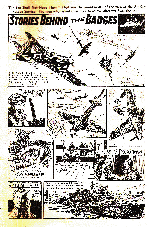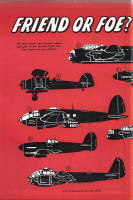Battle of Britain strips from The Victor and Hornet.

The badge of the Royal Air Force (RAF).
When people think of the Battle of Britain, they usually think of the squadrons, the planes and the pilots. True, the pilots were at the sharp end, but
without the contributions of many other
departments and sections of the RAF and other organisations, the pilots would never have got off the ground, nor found the enemy, nor destroyed the
Luftwaffe in the air. It was teamwork which enabled the RAF and Britain to win the battle.
Some of these organisations include the following. (But this is by no means a complete list).
The men and Women of the Air Transport Auxiliary (ATA), who flew new planes from the factories to airfields (usually unarmed and with no radio, with
many male and female pilots losing their lives as a result), during the Second World War, including through the Battle of
Britain. The Women's Auxiliary Air Force (WAAF) plotters and other personnel in the various control rooms, ground crews, Air-sea Rescue launches,
RAF emergency fire and medical teams, the
Observer Corps, countless other departments and commands of the RAF and so on. The people and emergency services of London and other cities and
industrial sites also played their part
in the Battle, when Hitler turned his attention away from the airfields to bombing the civilian targets instead. This was known as the Blitz.
The strips on this page celebrate some of their contributions during the Battle of Britain.
Other pages of interest elsewhere on this site include - The Blazing Ace of Space strip -
The stories below are about the Auxiliary Fire Service, the RAF Air-Sea Rescue squads and the men of the Air Transport Auxiliary.
These stories are from the Victor issue 100, Hornet issues 127 and 144. Finally Victor issues 788 and 845 respectively. The artist for the first strip is
not known, whilst Farrugia drew the strips featuring the ATA, ARP Rescue Squad and the Air-Sea Rescue strips. Sutherland drew the Hornet cover story.
Apologies for the state of several of the scans, some of the pages are in a poor state.
Please note all images (apart from the RAF badge above) on this page are copyright D.C. Thomson Co. Ltd.
The most famous British fighter plane during the battle was probably the Spitfire. The Hornet published a four page factual article about the plane in
issue 613. The artist is I think Ian Kennedy.
How good is your World War Two British and German aircraft recognition? How many aircraft silhouettes can you name? Try the quiz below. Pages from the
1976 Victor Annual. The painting below right, is of RAF fighter pilots scrambling for their Spitfire planes, as Luftwaffe (German Airforce), planes
attack their airfield. This beautiful painting was published on two A3 pages in the Victor Summer Special 1980 issue. Artist not known.
Next, we have two stories about the defusing of German bombs during the Blitz, one in a Hurricane factory, Weybridge Surrey (artwork by Harry Winslade),
and another in the East End of London (artwork by Philpotts). Both stories are from The Hornet issues 139 and 295 respectively.
Finally, below there are four true story adventures of RAF pilots experiences during the Battle of Britain. These stories appeared on the
front and back covers of the Victor. Issues 34, 161, 650 and 149 respectively. The artwork for issue 34 is by an unknown artist. Keith Shone drew the
artwork for issue 161, Philpotts drew issue 650 and Coleman issue 149.
 |
© Adrian Banfield, 2010.



































